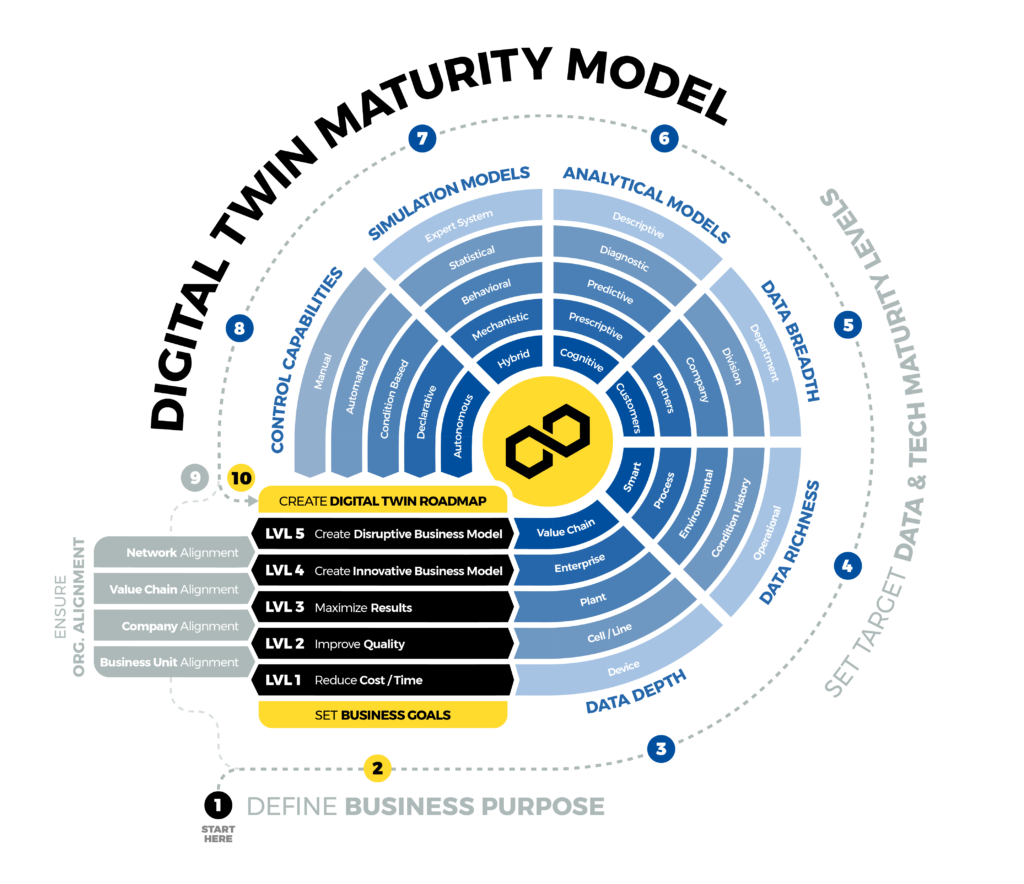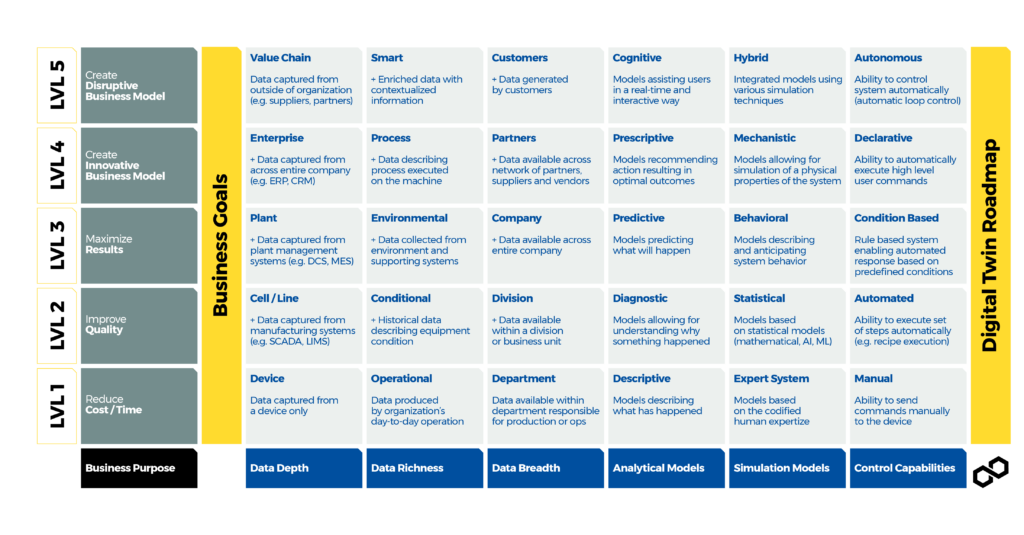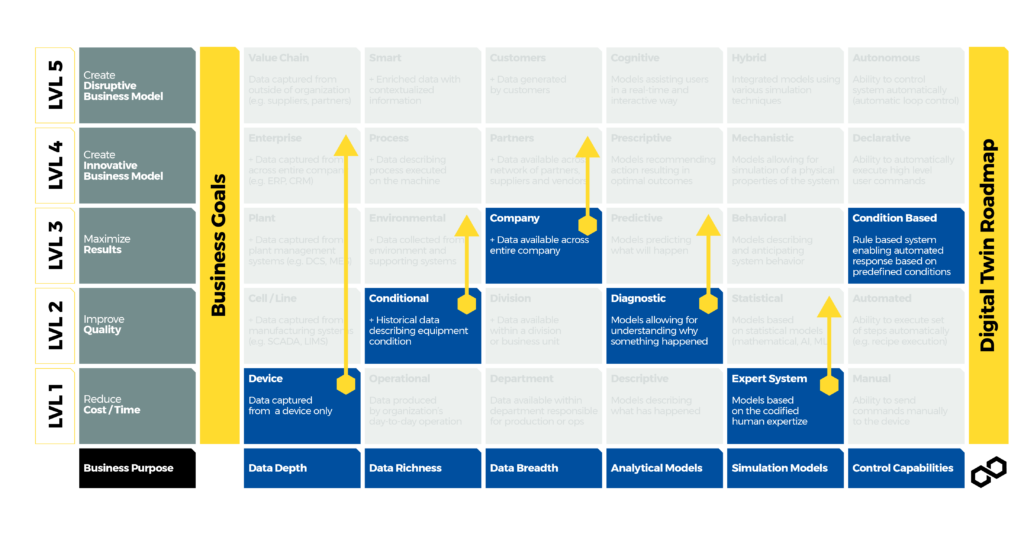7 min read

Initially, defining what a digital twin even is seemed simple – we have a real product and its virtual counterpart, and we combine the two. But how, when, and for what purpose?
Almost everything has changed in technology since Apollo 13 when the creation of a ground-based model made it possible to bring astronauts safely to earth. Nowadays, behind the term digital twin, there is a wide variety of solutions using, in addition to simulations and mathematical models, the Internet of Things, AI, and other technologies needed for the Industry 4.0.
While the tech side of the digital twin is fascinating, before we get excited about the technology, we need to consider how much we need this tool and what our business goals will be met. Like any tool, a digital twin must be for something, have specific parameters, and be tailored to the situation. If not, we get a costly ornament instead of a solution.
We have created a Digital Twin Maturity Model to help our partners and customers avoid mistakes. It combines business goals and objectives with technology and data tools and links them to business results. That allows us to optimize solutions and avoid the pitfalls of stunning visualizations that give us no benefit.

How to follow the digital twin maturity model?
Follow the guidance in the model. You will be able to identify and create, customize and expand your digital twin in precisely the way that suits your company’s current needs and capabilities. Below, point by point, we will explain the next steps in the process highlighted in our diagram.
On the outer circle, we presented the three main parts of the model: Business Purpose, Data & Technology Enablers, and Organizational Alignment.
Business Purpose
The Business Purpose is determined case-by-case for each client, project, or initiative. It should also reflect the business intent of the digital twin. These could be goals related to, for example, reducing costs, increasing flexibility, or unique product presentations that give customers an extraordinary experience and understanding.
Once the overall business goal is named and defined, measurable objectives need to be given. To be sure, it’s a good idea to use the SMART approach and include those values that are indeed specific, measurable, achievable, relevant, and time-bound.
Data and Technology Enablers
At this level, we move to the next element of the model – defining data and technology. We have presented six leading factors in our diagram, but they are not the only ones. Their selection depends on the company-specific context. Let’s take a look at these six categories you should take care of:
Data Depth
It allows us to see how deep we can go within the organization to obtain data relevant to the digital twin. It involves collecting data from the device, the entire company, and its ecosystem.
Data Richness
This aspect determines the type of data collected and used by the digital twin. It starts with operational data from the equipment and gradually enriches it with additional information. The result is creating the smart data concept to make actions more effective. Smart data includes self-describing, contextual information allowing for deep reasoning and supporting prescriptive and cognitive analysis.
Data Breadth
In this approach, the most important thing is to focus on the data sources used to define the digital twin. In a silos system, you start with a bottleneck, where the data source is limited to one department or unit and then extended to the entire company ecosystem.
Analytical Models
That defines the level of maturity for analytical models used within the digital twin solution. It starts with simple descriptive models and ends in advanced, cognitive solutions leveraging contextualized information available within the digital twin.
Simulation Models
These capabilities relate to the simulation of relevant physical systems. Simulations start with simple expert-based techniques up until creating hybrid models using statistical, behavioral, and mechanistic simulation models.
Control Capabilities
Their task is to determine the capabilities and ways to control a physical system with a digital twin. They start with simple, manual control and end with a fully automated approach to the control loop.
Maturity level is crucial for your business goals
Lastly, we are at the final stage of our model and can type the last step: determine the maturity level.
Before you and your consultants sit down to work, you need to know that a company can simultaneously be at different maturity levels, depending on other dimensions. Also, the time it takes for companies to move to the next level can vary greatly. However, the overall level of maturity is much less important than the business goal of investing in and strengthening maturity in a particular area. As you go through the meanders of assessing the situation, don’t lose sight of why you’re doing it.
The five maturity levels you see below define the potential impact of a digital twin on your business. Most importantly: the higher the maturity level, the more disruptive the effect will be. That’s why you should evaluate each data and technology influencer according to maturity levels.
Five maturity levels
Level 1: Reduce Time/Cost.
At this level of maturity, companies work in a safe and familiar domain and focus on speeding up processes and reducing costs.
Level 2: Improve Quality
Companies are still working in their core business, but their focus is on improving the quality of the production process or the products themselves.
Level 3: Maximize results
This company goal entails changes in the way they work. At this level, optimization techniques offered by digital twin, new tools, processes, and workflows are used.
Level 4: Create an Innovative Business Model
This level is a time of change and revolution in the scope of business. To achieve this, companies must look at the value digital twin provides holistically. Decision-making processes are enterprise-wide and based mainly on data. New business models are also being adopted.
Level 5: Creating Disruptive Business Model
Companies are leaving the safety zone and seeking to transform their industries. Their decisions, processes, and investments extend the impact beyond the organization’s boundaries.
Check the graph below to clarify the information contained in the level descriptions. It describes the data and technologies necessary for each maturity level.

Based on our experience and observations, we have defined four Organization Alignment levels necessary for a firm to move from one level of a digital twin to another.
Four stages of Organizational Alignment
Business Unit Alignment
That is the level at which the standard way of working is agreed upon. Processes and changes primarily affect a department or designated group of people. At this stage, decision-makers define common procedures and reporting standards within the business unit or department responsible for implementing and adopting the digital twin.
Company Alignment
That is a stage built on top of the previous one. The processes, standards, and practices of data management and the tools used to go beyond the scope of a department or group to encompass the entire organization. That ensures that standard methods are internalized and practiced by everyone at all organizational levels of the company.
Value Chain Alignment
Practices, ways to share and protect data, and processes are being extended to all participants in production or manufacturing. That means that changes and new procedures will also extend to vendors, suppliers, partners, contractors, and customers themselves.
Industry Alignment
The gains and opportunities afforded by the proper introduction and application of the digital twin become visible throughout and accepted by the industry. New practices become the foundation for common standards and best practices. Participants in the ecosystem agree to cooperate and be transparent, even if they are competitors to each other. The market, having common mechanisms, develops more efficiently, and all players reap tangible benefits.
As you can see from the model’s graphic, Organizational Alignment connects strongly with maturity levels. The placement on the graph, of course, is not coincidental. The levels at which the business objective is positioned indicate the requirements and readiness within the entire company and its environment.
The success of digital twin adoption is primarily related to organizational capabilities. Its integration into the company’s work requires readiness or preparation for the willingness of the company’s people, processes and culture. If they do not go through their process of adaptation and change, the digital twin’s adoption will hang in a corporate vacuum. In that case, its benefits will not be realized, and its potential will not be used.

Trying to skip a given level, jumping in too high, not paying attention to internal processes and changes within the work culture, or making the wrong choice of technology can jeopardize the entire enterprise.
Why use the Digital Twin Maturity Model
Maturity models are helpful and valuable tools for defining and implementing digital strategy. This particular one also applies to various domains, from an overall assessment to evaluating specific subdomains.
The Digital Twin Maturity Model has been successfully validated in several meetings with industrial and biotech companies and has been successfully adapted to rapidly changing technologies and market requirements.
Our model aims to identify a set of capabilities and enablers. Picking them out and placing them in the specific customer’s context will allow the company to leverage the digital twin as favorably as existing technology grants.
It also marks a critical topic – setting business goals, gathering knowledge about technology enablers, or making future processes more measurable is just the first step into digital twin adaptation. Between that moment and costly investment are one more crucial moment – a realistic assessment of the company’s situation and possibilities.
We propose that approach because it helps realize expectations and creates a roadmap for consistent and successful implementation of the digital twin strategy. The assessment also forces business and technical stakeholders to collaborate to define a shared vision of digital twin adoption.
Finally, it allows you to focus on facts, measures, and specific goals, not on misleading advertisements, proposals, or vague promises of success.
Summary
To make your vision realistic and turn it into benefits, we strongly suggest starting your discussion about digital twins by formulating the business purpose. The next step is to define business goals, which makes the initiative measurable. After that, it is time to set target maturity levels to understand what you have to achieve for each data and technology enabler. The organization should also assess the Organization’s Alignment with the digital twin vision. The final step is creating a roadmap that acts as a company-wide guide for implementing a digital twin.

We designed our Digital Twin Maturity Model to support teams in creating robust, transparent, and adequate strategies. Assessing the company’s current readiness to adopt digital twin technology makes going to the next level easier and much more efficient. It also makes the whole process based on the prioritization of learning and structure. And last but not least, it gives companies a list of things to improve before they dive deeply into new technologies.






